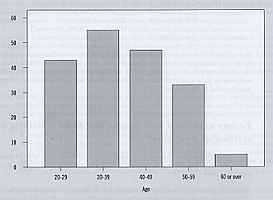 and reach thousands of daily visitors
and reach thousands of daily visitors11 APRIL 2008
NO 1284
Staff retention
Factors associated with length
of time at current establishment
Our second main research question addressed the factors associated with
the length of time served by our respondents at their current
establishments.
Figure 3 provides information about the age of the residential group workers. It is often assumed that residential group workers in the United Kingdom are young, inexperienced people, who are left to cope with some of the community's most difficult young people. However, Figure 3 shows that our sample of group workers was predominantly over 30 years of age, with substantial numbers over 40 and over 50 years of age.
A significant, and fairly strong, positive correlation was found between time at current establishment and age of respondents (rho = 0.449, N = 183 p = < 0.0005, two-tailed). It may also be noted that a significant, and strong, positive correlation was also obtained for years in residential group care and the age of respondents (rho = 0.526, N = 183, p = < 0.0005, two-tailed).
As previously indicated, some two-thirds of our respondents were female. The mean length of time served at current establishment was 3.95 for male respondents (N = 62) and 5.38 (N = 120) for female respondents. The difference in question fell just short of statistical significance at the 0.05 level (Mann-Whitney U = 3245, p = 0.10; N.B. the non-parametric Mann-Whitney was used because data regarding length of time at current establishment were not normally distributed). Female respondents had, on average, also served longer in residential group work than their male counterparts. The mean number of years in residential group work was 8.29 for female respondents and 7.95 for males, but the difference was not statistically significant (Mann-Whitney U = 3671.5, p = 0.88).
We then explored possible relationships between the length of time that respondents had served at their current establishments and their perception of the following: support systems; sources of help; communication; residents; training; recruitment and staffing issues; morale and job satisfaction. A full discussion of our findings in respect of the six dimensions of working environment lies outside the scope of this paper. However, it may be noted that, overall, scale scores indicated that respondents generally held rather positive perceptions of their working environments. Moreover, the majority(70%) perceived morale in their workplace as high, and three-quarters were either satisfied or very satisfied with their jobs. On the other hand, it is evident that a significant minority of respondents – 30% – reported that morale was low, while a quarter of respondents were either dissatisfied or very dissatisfied with their jobs.
A statistically significant, but small, correlation was observed between time served at current establishment and perception of staff morale (rho = 0.167, N = 183, p = 0.05, two-tailed). However, a negative correlation was found between time at current establishment and perceptions of residents (rho = -0.283, N = 153, p = < 0.0005, two-tailed). Thus, it would appear that the longer respondents had worked at their current establishments the more likely they were to hold negative views on the issues relating to the children and young people accommodated addressed by the relevant scale. However, although statistically significant the correlation concerned is rather small.
Further, the correlations observed between time served by respondents at their current establishments and the following variables were not significant:
It is evident that the largest of our statistically significant correlations concerned time served by our respondents at their current establishments, years worked in residential group care, and the age of respondents, suggesting strong relationships between these variables (N.B. cases with missing data were excluded on a pair-wise basis, hence the variation in the number of cases included in the analyses).

Figure 3. Age of residential group workers
M.COLTON AND S.ROBERTS
Colton, M. and Roberts, S. (2006). The retention of residential group care workers. International Journal of Child and Family Welfare, 9, 3. pp. 167-168.